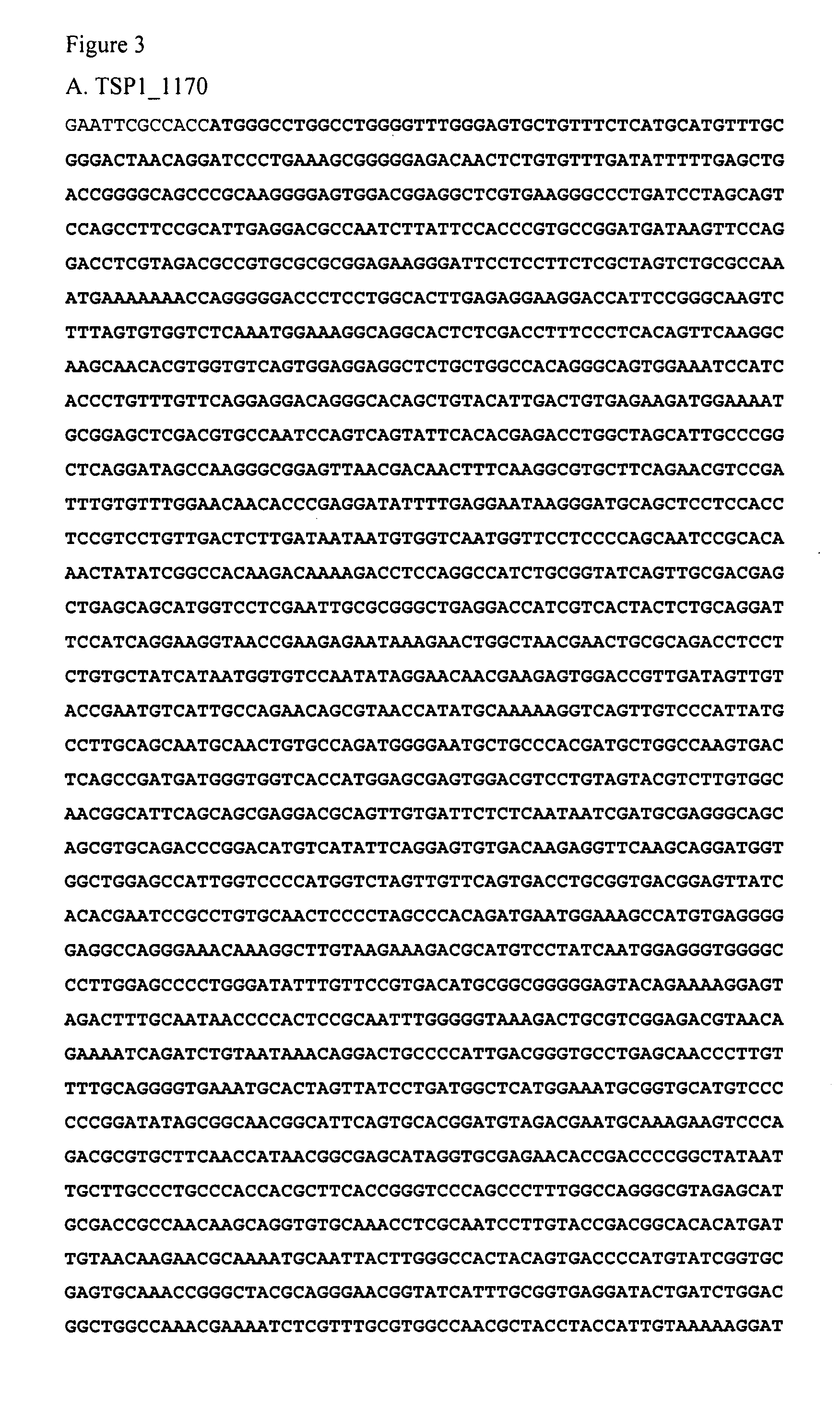Novel thrombospondin-1 polynucleotides encoding variant thrombospondin-1 polypeptides and methods using same
- Summary
- Abstract
- Description
- Claims
- Application Information
AI Technical Summary
Benefits of technology
Problems solved by technology
Method used
Image
Examples
example 1
[0313] Description of the methodology undertaken to uncover the biomolecular sequences of the present invention and uses therefor
[0314] Human ESTs and cDNAs were obtained from GenBank versions 136 (Jun. 15, 2003 ncbi “dot” nih “dot” gov / genbank / release “dot” notes / gb136 “dot” release “dot” notes) and NCBI genome assembly of April 2003. Novel splice variants were predicted using the LEADS clustering and assembly system as described in U.S. Pat. No: 6,625,545, U.S. patent application Ser. No. 10 / 426,002, both of which are hereby incorporated by reference as if fully set forth herein. Briefly, the software cleans the expressed sequences from repeats, vectors and immunoglobulins. It then aligns the expressed sequences to the genome taking alternatively splicing into account and clusters overlapping expressed sequences into “clusters” that represent genes or partial genes.
[0315] These were annotated using the GeneCarta (Compugen, Tel-Aviv, Israel) platform. The GeneCarta platform inclu...
example 2
Description for Cluster Humthrom
[0341] Cluster HUMTHROM features 5 transcripts the names for which are given in Table 1. The selected protein variants are given in Table 2.
TABLE 1Transcripts of interestTranscript NameHUMTHROM_1_T12 (SEQ ID NO:1)HUMTHROM_1_T14 (SEQ ID NO:2)HUMTHROM_1_T15 (SEQ ID NO:3)HUMTHROM_1_T17 (SEQ ID NO:4)HUMTHROM_1_T32 (SEQ ID NO:5)
[0342]
TABLE 2Proteins of interestCorrespondingProtein NameTranscript(s)HUMTHROM_1_P8HUMTHROM_1_T12(SEQ ID NO:48)(SEQ ID NO:1)HUMTHROM_1_P10HUMTHROM_1_T15(SEQ ID NO:49)(SEQ ID NO:3)HUMTHROM_1_P12HUMTHROM_1_T17(SEQ ID NO:50)(SEQ ID NO:4)HUMTHROM_1_P22HUMTHROM_1_T32(SEQ ID NO:51)(SEQ ID NO:5)HUMTHROM_1_P27HUMTHROM_1_T14(SEQ ID NO:52)(SEQ ID NO:2)
[0343] These sequences are variants of the known protein Thrombospondin 1 precursor (SEQ ID NO:44) (SwissProt accession identifier TSP-1_HUMAN), referred to herein as the previously known protein.
[0344] Protein Thrombospondin 1 precursor (SEQ ID NO:44) is known or believed to have the follo...
example 3
Validation, Cloning and Expression of TSP-1 Variants
[0389] This example relates to the validation, cloning and expression of TSP-1 variants according to the present invention. The following TSP-1 variants were selected: TSP-1—1170 (wt) (SEQ ID NO:54); TSP-1—1112 (SEQ ID NO:56); TSP-1—685 (SEQ ID NO:58); TSP-1—555 (SEQ ID NO:60); TSP-1—173 (positive control) (SEQ ID NO:62).
[0390]FIG. 1 provides a schematic drawing of TSP-1 variants of the present invention as well as a known TSP-1 and a previously described P173 anti-angiogenic TSP-1 fragment, also known as the 3TSR fragment (Miao et al. (2001), Cancer Research 61, 7830-7839; Short et al. (2005), J. Cell Biology 168, 643-653). TSP-1 variants of the present invention, depicted in FIG. 1, are TSP-1—1112 (SEQ ID NO:5, 51); TSP-1—685 (SEQ ID NO:4, 50); TSP-1—555 (SEQ ID NO:2, 52), TSP-1—578 (SEQ ID NO:1, 48) and TSP-1—804 (SEQ ID NO:3, 49). All variants include the 3TSR domains that are necessary for activity. Of the five variants, fo...
PUM
| Property | Measurement | Unit |
|---|---|---|
| Fraction | aaaaa | aaaaa |
| Fraction | aaaaa | aaaaa |
| Fraction | aaaaa | aaaaa |
Abstract
Description
Claims
Application Information
 Login to View More
Login to View More - R&D
- Intellectual Property
- Life Sciences
- Materials
- Tech Scout
- Unparalleled Data Quality
- Higher Quality Content
- 60% Fewer Hallucinations
Browse by: Latest US Patents, China's latest patents, Technical Efficacy Thesaurus, Application Domain, Technology Topic, Popular Technical Reports.
© 2025 PatSnap. All rights reserved.Legal|Privacy policy|Modern Slavery Act Transparency Statement|Sitemap|About US| Contact US: help@patsnap.com



